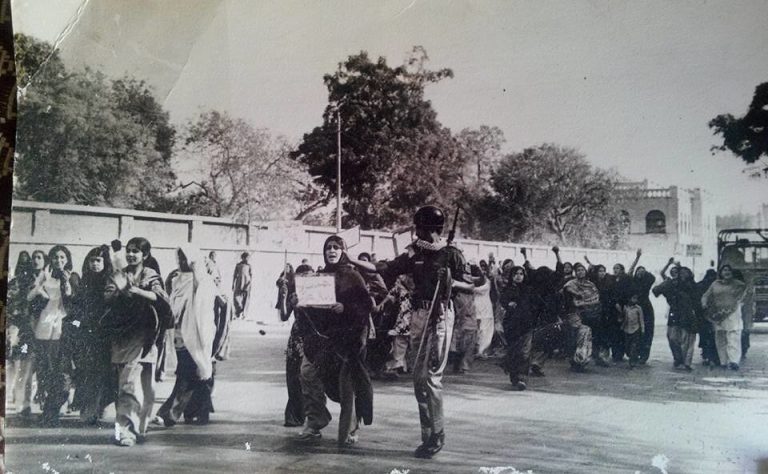
Created in early ‘80s, the organization struggled against the notorious dictator Gen. Zia’s regime throughout his rule as part of the wider pro-democracy movement. After Gen. Zia’s death in 1988, it fought for Sindh’s due share of water, challenging the construction of various dams that left the province dry, and for several other issues.
Gohar Ali Memon
The Sindhiyani Tehreek (ST) was a women-led political organization formed by rural women in Pakistan’s southern province of Sindh. Created in the early ‘80s during General Zia-ul-Haq’s regime, the group struggled against the notorious dictator throughout his rule as part of the wider pro-democracy movement. After General Zia’s assassination in 1988, the ST fought for Sindh’s due share of water, challenging the construction of various dams that left the province dry. The anti-dam movement continued throughout the regimes of Benazir Bhutto, Nawaz Sharif and General Musharraf. The ST’s women leaders, despite their old age, continued to resist.
But what initially kindled their spirit of rebellion? In a largely male-dominated, patriarchal and feudal society – where honor killings are rampant, female literacy in rural areas barely touches 25% and domestic violence mostly goes unreported – how could these rural women lead a resistance against Pakistan’s most notorious dictatorial regimes? And what lessons can this movement offer to Pakistan’s recent wave of feminist resistance? Indeed, can the Sindhiyani Tehreek even be called “feminist”? These are some questions I hope to address.
The Ideological Roots of the Sindhiyani Tehreek
The ST was formed by women affiliated with the Awami Tehreek, a Left-leaning Sindhi political party. The Awami Tehreek was the brainchild of Rasool Bux Palijo, a veteran leftist intellectual and politician with his own distinct political thought. Palijo distanced himself from traditional communists in Pakistan on the “national question”, and from conventional nationalists within Sindh on the question of class struggle.
Palijo’s disagreement with Pakistan’s traditional Left was rooted in Sindh’s estrangement from the monolithic policies of a federated Pakistan – a federation the predecessors to the Pakistani Left helped create. With its Adhikari thesis, the Communist Party of India supported the idea of Muslim nationhood and instructed Muslim comrades to cooperate with the Muslim League. The League was considered anti-imperialist and the right to secession was accepted under the pretext of a right to self-determination. Thus, communists conceded to both the idea of Pakistan and to the Muslim League, a party run by the feudal elites of United India. To some extent, this concession lived on in the post-Partition Pakistani Left, as issues like language and the decentralized distribution of water were not given credence in leftist discourse.
In 1954, the Pakistani government banned the Communist Party of Pakistan and imposed the One Unit Scheme, stripping the provinces of a relative autonomy promised in the Lahore Resolution. Then, in 1955, the Kotri Barrage was constructed near Hyderabad, followed by northern Sindh’s Guddu Barrage in 1962. Both dams made portions of Sindh’s land fertile. But instead of going to Sindh’s peasantry, this land was distributed among Pakistan’s non-Sindhi military and bureaucratic elites. Problems for Sindhi peasants were exacerbated by the signing of the World Bank-brokered Indus Water Treaty by Pakistan and India in 1960. The treaty spelled disaster for Sindh as it was the lower-riparian. Perennial water shortages since then have threatened the very survival of the province’s inhabitants. Combined with the language issue, which stemmed from Jinnah’s declaration of Urdu as the country’s sole national language, the loss of autonomy, and the distribution of barrage land to non-Sindhi elites, this sowed the seeds of discord amongst the province’s peasants and fanned Sindhi nationalism.
It is an irony of history that Sindh was the first province to pass the Pakistan Resolution. G. M. Syed, the leader of the Sindh Muslim League who helped pass the resolution, considered the Muslim League an antidote to the centralizing policies of Congress. However, less than a decade after Pakistan’s creation, Sindh was stripped of its autonomy. G. M. Syed was also arrested. The military dictator at the time, Field Marshall Ayub Khan, ruled with an iron fist: signing the anti-Sindh Indus Water Treaty and distributing lands of Sindh to non-Sindhi elites. He even enjoyed the support of some pro-China leftist groups within Pakistan because of his amorous relationship with the Chinese. Though a Marxist-Leninist, Palijo disagreed with those leftist groups that considered issues like provincial autonomy, water distribution, and linguistic sovereignty as regressive forms of nationalism. He believed they were foreign policy agents of Moscow or Beijing instead of genuine Marxists. They should have worked to put their own house in order, settling scores with Pakistan’s own bourgeoisie, pushing for the right to self-determination of smaller nations within their own country, before embarking upon the mission of creating an egalitarian world.
But Palijo also had his disagreements with the Sindhi nationalists. In 1966, after his release from prison, G. M. Syed thought little room was left for any open political activity in the country. So instead, he created various cultural fronts to instill political consciousness within Sindhis. Prominent among these were the Bazm-e-Sufia-e-Sindh, a cultural organization, and the Jeay Sindh Student Federation. The young Palijo was part of the Bazm.
“In a largely male-dominated, patriarchal and feudal society – where honor killings are rampant, female literacy in rural areas barely touches 25% and domestic violence mostly goes unreported – how could these rural women lead a resistance against Pakistan’s most notorious dictatorial regimes?”
The state soon realized Syed’s intentions and he was arrested again. Over the course of Zulfikar Ali Bhutto’s regime – when he acquiesced to Muhajir demands by making Urdu an official language of Sindh along with Sindhi, and promulgated a new constitution in 1973 that did not accept provinces as constituent states but merely federating units – Syed lost hope in the prospect of Sindhi autonomy within Pakistan. He formed Jeay Sindh Muttahida Mahaz, which promoted the policy of “Sindhudesh”: that is, complete secession from Pakistan. Palijo, however, disagreed with Syed. Without the support of the proletariat and peasant mass base, and without a revolutionary program and a vanguard party, this policy, he believed, would end in disaster. Palijo believed that a cultural movement relying largely on students, as Syed’s movement did, had its limitations. Without a mass base, the nationalist movement would be hijacked by feudal and other elite classes, and possibly crushed by the state in its infancy.
“Though a Marxist-Leninist, Palijo disagreed with those leftist groups that considered issues like provincial autonomy, water distribution, and linguistic sovereignty as regressive forms of nationalism”
In response to these prevailing Left and nationalist currents, Palijo and his Awami Tehreek presented the program of a “National People’s Democratic Revolution”. The program was nationalist, since they believed in the national rights of Sindhi people, socialist and democratic because they rooted themselves in a proletariat/peasant mass base and engaged in class struggle, and revolutionary because they did not believe in parliamentarianism or bourgeois reformism. In this, Palijo was inspired by communist currents in the anti-colonial movements of China, Algeria, and Vietnam. After creating the Awami Tehreek in March of 1970, Palijo introduced Marxist-Leninist ideas in Sindh, wrote books on Ho Chi Minh and Mao, and even translated those communist texts essential for building a revolutionary nationalist organization. He thought that history had put Sindh in a sensitive position, where its people had to combat both the neo-colonial designs of the Pakistani state and Sindh’s corrupt feudal elite. It was therefore necessary, Palijo believed, to build a movement that was both nationalist and revolutionary socialist.
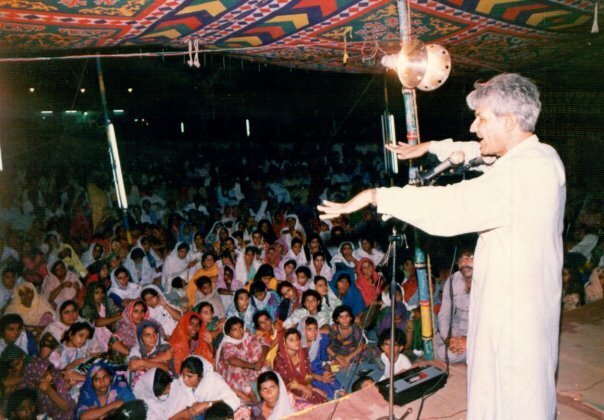
This movement, Palijo also insisted, should include women.
With this program, he started organizing women in and around his home in Jungshahi, a small rural town in the Thatta district of Sindh. Women of his clan, in particular, participated in demonstrations, protests, and programs organized by the Awami Tehreek. When One-Unit was lifted and new elections announced, Palijo agitated for publishing voter-lists in Sindhi. The voter-lists were published only in Urdu, another reiteration of the old language bias that haunted the smaller provinces ever since Pakistan’s inception. Akhtar Baloch, Palijo’s step-daughter, was a key leader of the agitations around voter lists. She was arrested by police and put behind bars. Her collection of prison notebooks, Prison Narratives, were recently translated and published in English. Baloch was one of many women ideologically trained and inspired by Palijo and Awami Tehreek. Most of these women came from rural Sindh and would go on to form the ST in the early ‘80s.
Sindhiyani against Martial Law
In 1979, Prime Minister Zulfikar Ali Bhutto was hanged by the Martial Law administration of General Zia-ul-Haq. That year, General Zia also enacted the Hudood Ordinances, a series of laws that instilled Shariah injunctions into Pakistan’s Penal Code. One of its most controversial aspects was the Zina ordinance, which outlawed extra-marital sex. The ordinance was particularly harmful for women as they lost their legal protection against rape and sexual assault. Under the new law, a sexually assaulted woman had to produce four witnesses in court to testify that the assault took place. If no witnesses could be found, the woman herself would then be accused of extra-marital sex and face rigorous imprisonment. She could even be stoned to death.
The Zia regime then went even further in its Islamization (and essentially anti-women) program. A separate court named the Federal Shariat Court was established in 1980 to deal with affairs related to Sharia laws. In 1984, the Qanun-e-Shahadat Order was passed, which reduced the testimony of a woman in court to half that of the man. Zia even ordered that women could only appear on TV with a headscarf.
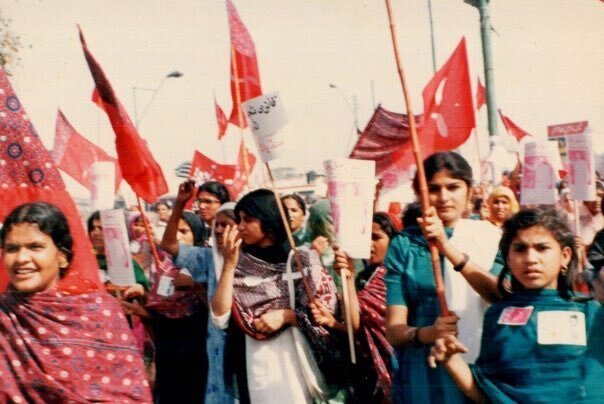
It was against Zia’s misogynistic program that the Women’s Action Forum, an urban-based women’s movement, was formed. The emergence of this group was contemporaneous with the ST, whose mass base, in contrast, was largely rural women. A year after the formation of the ST in 1982, the anti-Zia Movement for the Restoration of Democracy (MRD) began. Although spread across Pakistan, it was in Sindh that the movement had its greatest appeal. Zulfikar Ali Bhutto’s Pakistan People’s Party, now led by Benazir Bhutto, along with Awami Tehreek and other secular democratic parties, mobilized people across Sindh. The ST participated in the movement with full vigor. People from small towns and villages in Sindh came out to demonstrate against the dictator. It was in Sindh that people confronted army vehicles with empty hands and bare chests. Many protesters were beaten, tortured, and thrown into prison. Many of the Awami Tehreek’s members languished in jails, their families awaiting their return.
The ST continued to organize, especially by mobilizing women related to the (mostly male) incarcerated comrades. Women comrades like Shahnaz Rahu, daughter of the Awami Tehreek’s peasant leader Fazil Rahu, and Ghulam Fatima and Hoor un Nisa, both sisters of Palijo, started visiting the homes of their incarcerated comrades, encouraging their families to join the struggle. The ideologically trained women of the ST had immediate success in the project. Many women from Sindh’s rural areas participated in the MRD from the platform of the ST.
Hoor Palijo, the ST’s founding member, was assigned the task of organizing women for demonstrations. She even prepared them for the arrests they would most likely court by protesting. Hoor especially took advantage of the classroom to mobilize. She was a college lecturer in Thatta District and, after holding classes, would take her female students and others on a train to Hyderabad to attend protests in the city. Prepared for the likelihood of arrest, women even brought their jail-bags along. The ages of women protestors varied between the young and old. Several women, including Kulsoom Palijo, Shabnam Palijo, and Marvi, were even 6th grade students.
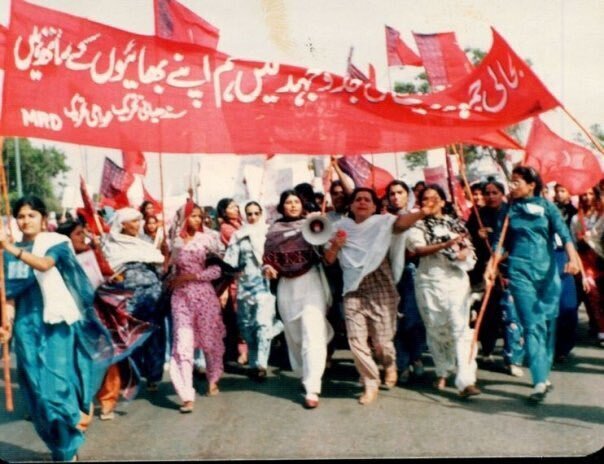
It was an everyday routine for Hoor and her comrades to prepare women for the demonstration at Hyderabad. In Hyderabad, these women were joined by women comrades from other rural towns like Larkana, Sukkur, Badin, Sanghar, Khairpur, and Dadu. In jail, Sindhiyanis, as they were called, were not desolate and weary souls. They kept their revolutionary fervour, singing revolutionary songs, organizing study circles and chanting slogans against General Zia. In a feudal society, where women are considered inferior to men, where they are expected to be meek and passive, the ST was a thunderbolt. It gave rise to revolutionary women who courageously fought to fundamentally transform society. Their fortitude and daring to take risks can be gauged from this incident narrated by Hoor:
As per our routine, we were coming back to Jungshahi from Hyderabad via train. At the station, we noticed some suspicious movement of army soldiers. I had this thought that they might have come to arrest us. We were not terrified, absolutely not, but it was against our party policy to get arrested in some dark train corridor with no witnesses, and no one to resist and agitate on the ground. We boarded the train, and so did they. We were in the same cabin. We had already chalked out the areas between Jungshahi and Hyderabad, where in case of an emergency, we would disembark and stay. There was a station named “Latif Chang” on the way. We were in a state of indecisiveness due to the presence of the soldiers in the same cabin. We thought that the station had come and all 17-18 of us jumped out of the moving train, and fell at a distance from each other. With injured limbs, we held on and reached a village. The villagers, with their values of hospitality, tried their best to be hospitable to the injured women but their material inadequacy was a stumbling block in their zest of cooperation. There was only one cycle in the village and God knows how we transported the injured to the main road one by one.
In 1984, Benazir Bhutto went into exile. Palijo and his ally Fazil were arrested. The pace of the movement slowed. But in 1986, it began to gain ground again. Although on her return in 1986, Benazir Bhutto declared that she did not believe in the politics of revenge and wanted to peacefully restore democracy, the military regime’s paranoia did not end. Many continued to be arrested. Sindhiyanis were yet again at the forefront, protesting for the safe release of all political prisoners, including their leaders who were incarcerated in Lahore’s Kot Lakhpat jail. General Zia’s grip weakened further, but before he could be formally ousted, he was killed in an air crash in August 1988.
Anti-Dam Movements
The problems plaguing the Pakistani state since its inception have continued to express themselves in one form or another. The language issue remains unresolved till this date, and provincial autonomy has dwindled at the hands of both dictators and civilian advocates of centralization (like the current Imran Khan government). Likewise, the equitable distribution of irrigation water – or the dam question – is still a source of resentment for many Sindhis.
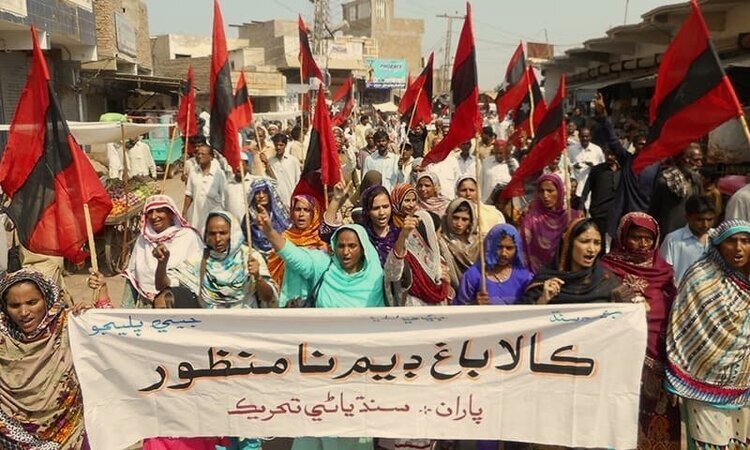
After the signing of the Indus Water Treaty in 1960, Pakistan sold three of its six rivers to India and planned to build dams and canals with that money. Pakistan’s remaining rivers suffered reduced flow as water was channeled into large reservoirs. Tarbela Dam, for instance, was created out of the Indus while Mangla Dam was created out of the Jhelum River. Sindh suffered further reductions to its only source of water, through projects like the Chashma-Jehlum Link Canal. This canal was originally built to store floodwater, but remains filled even in normal times, creating perennial water shortages in Sindh.
With its economy largely dependent on agriculture, Sindh has repeatedly protested against further cuts on the Indus River. The proposal for the Kalabagh Dam, a dam proposed to be built on the Indus River in Punjab’s Mianwali district, has been met with especially strong disapproval in Sindh. Anti-dam protests have, however, fallen on deaf years. Elites argue that dams are necessary for the production of hydro-power and development more broadly, a discourse widely peddled by the national media.
“[Palijo] thought that history had put Sindh in a sensitive position, where its people had to combat both the neo-colonial designs of the Pakistani state and Sindh’s corrupt feudal elite.”
Discourse in favor of the Kalabagh Dam entered the mainstream in late ‘80s. Palijo started mobilizing people against it and the Sindhiyanis soon joined the movement as well. Sindhiyanis participated in long marches. In sweltering summer days, they walked on foot, with their children hanging around their waist. The same revolutionary fervour was back. This movement was so overwhelming that it also brought Benazir Bhutto (then a former Prime Minister) into the fold. In the late ‘90s, she joined one of their protests in Obauro, a small town in Ghotki. In another instance, Benazir Bhutto came to welcome the Long March in Karachi, which had started off from Sukkur. Zahida Shaikh, Palijo’s late wife and leader of the ST, has noted that “when Benazir Bhutto saw the large crowds of women lining up against the Kalabagh Dam on the streets of Karachi, she asked Palijo ‘Is this a women-only march?’ To which, Palijo replied ‘It is led by women. On your way to the airport, you would see that hundreds and thousands of Sindhis have lined behind their brave sisters’”.
The Kalabagh Dam discourse gained pace during General Musharraf’s regime. Not long after ousting Nawaz Sharif in a coup in 1999, General Musharraf inaugurated the “Greater Thal Canal” project, which proposed to build a canal to the Thal Desert from the Indus. In response, people in Sindh launched another anti-dam movement. There were long marches and demonstrations. Sindhiyanis were once again ready for the arrests; their revolutionary zest at full throttle. In the blistering summers of Sindh, they recited verses from Shaikh Ayaz, the province’s eminent poet:
Hurka halo, dheema halo,
pand paray ho, ker karay ho,
waat await, deel daray ho,
poe b piryeen jo, pand bhalo ho,
pandh bhalo miya, hurka halo
(March fast, March slow,
The walk is long, who would undertake it?
The road is weary, the miseries may swallow,
Even then, the walk for beloved is worth it,
The walk is worth it, March fast)
In her memoirs, Zahida Shaikh notes that ST was an organization of poor rural women. They did not have the resources of other feminist organizations, most of which had become large donor-funded NGOs during the Musharraf-era. When the ST participated in a peasant conference in February 2004, they were told that there would also be an anti-Kalabagh convention later. The Sindhiyanis wanted to participate, but most of them had drained their purses on their long journey to the peasant conference. Those who could afford to go did, but many others couldn’t. Many of the latter women came largely from peasant and lower middle class backgrounds. Zahida also notes that once the ST was invited to a women’s convention in India. Members were worried about passports, as many did not have them. Eventually, the ST found six to seven women who did have passports to travel. But even in participating in these international conferences, the ST remained rooted to its women-base in rural Sindh. This is the reason why they were so threatening to Pakistan’s prevailing power structure.
Because of the resistance of organizations like the ST, General Musharraf eventually had to scrap his plans to build the Kalabagh Dam.
A Women’s Organization or a Feminist Organization?
The ST is often accused of being an organization of women, but not an explicitly feminist organization. Its critics also claim that it simply followed the dictates of its parent party, the Awami Tehreek, and did not chart an independent course. This controversy revives an old debate over whether radical women should form a separate organization or a subordinate wing of an existing Left party. Should this organization take up the issues of only women or those of society at large? Should its membership be open to everyone or to people with certain ideological leanings? The Women’s Action Forum also faced similar questions in its formative years. It finally decided that it would be an independent women’s organization, dedicated largely to issues affecting women (though it has recently expanded its constituency to include the transgender community). Its membership was also restricted (at least before the inclusion of transgender folks) to secular democratic women.
“In her memoirs, Zahida Shaikh notes that ST was an organization of poor rural women. They did not have the resources of other feminist organizations, most of which had become large donor-funded NGOs during the Musharraf-era.”
If one analyzes the ST on these questions, it is clear that this organization was inspired by Lenin. In his interview to Clara Zetkin on the “Women’s Question” Lenin addressed this question dialectically. He did not believe that women should form an independent party, since this divided the revolutionary movement (and its strength) along gender lines. Nor did he believe that the party should form a women’s wing completely under its control, as this effectively disempowered women. Instead, Lenin believed that there should be an independent women’s wing within the party, which would focus on issues affecting women and bring them into the fold of the revolutionary party more generally. He was of the view that women constituted a large part of the population, and that postponing their issues until after the revolution would make them vulnerable to enemies’ plots. Also, by focusing on issues affecting women, Lenin wanted them to realize that the revolutionary party recognized their oppression and exploitation. He advocated for an independent women’s front of the party, one that would bring women into the struggle against gender and class oppression.
The ST was, in essence, such a Leninist formation. It was not completely independent of the Awami Tehreek, but was instead an affiliated wing of the party. But it had an independent working mechanism, a separate constitution, and distinct areas of operation. The Awami Tehreek, in fact, had many fronts: the Sujag Baar Tehreek (Awakened Children’s Movement), the Sindhi Shagird Tehreek (Sindhi Students Movement), and the Sindhi Girls Students Organization. All of these fronts sent their observers into the each other’s meetings, in order to see whether their activities fall in line with the party’s revolutionary program. These observers could only give suggestions; final decisions always rested with the respective front, which had what we might call a “relative autonomy”. The Awami Tehreek’s Central Committee had no power to suspend the membership of any ST member. The ST was not bound to endorse the decisions taken by the Awami Tehreek. However, the ST, like the other fronts, could not suspend its ideological affiliation with the Awami Tehreek and had to always participate in the party’s major campaigns.
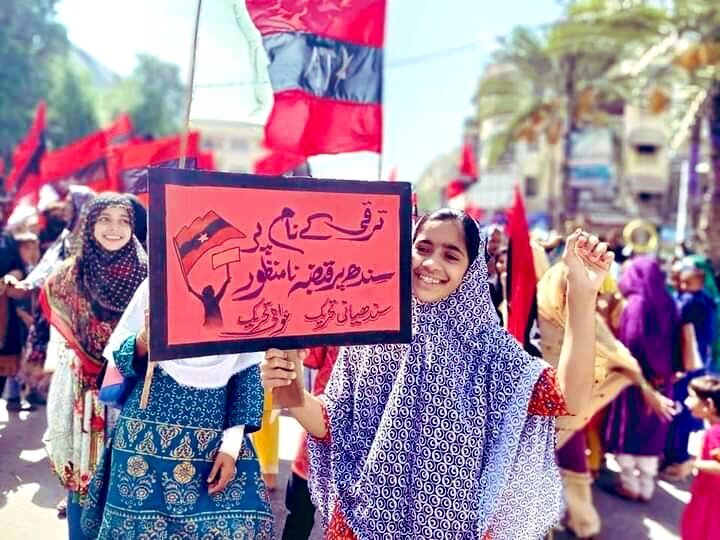
Nonetheless, it is true that the ST should have expanded its program to more women-specific issues like honour killings, domestic violence, acid attacks, child marriages, and the forced conversion of minor girls. In the mid-90s, they did document incidents of honour killings and campaigned against it, but they certainly could have done more. Part of the reason for this neglect, it needs to be said, may have to do with the organization’s relationship to the Awami Tehreek. Although ST comrades did participate in the Awami Tehreek’s central committee meetings, none of them could hold any important office in the party. Issues like dams and water shortages were given political urgency by the male leadership, such that Sindhiyanis could not redirect their energies to the explicit question of women’s empowerment. But, then again, what is the demand for the equitable redistribution of resources like water if not a demand, in effect, for women’s empowerment? From this demand, Sindh’s rural women, as well as its men, had much to gain.
A Sindhiyani for the Present?
Jami Chandio, a noted political commentator and close confidante of Palijo, believes that the ST largely derived its strength from the Awami Tehreek’s strongholds. With splits and internal mismanagement within the party, the Awami Tehreek suffered huge losses. With the death of Palijo in 2018, the party lost its direction. Most of its cadre are now spread into different splinter groups and political parties. With the Awami Tehreek in retreat, the ST is in search of a direction.
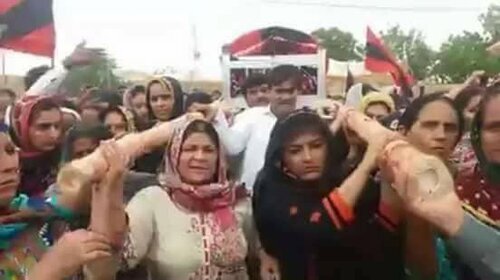
In the past two to three years, Pakistan has seen huge “Aurat Marches” (Women Marches). While these marches have certainly left an impact on society and have infuriated right-wing patriarchs, they are also largely urban and middle-class, excluding many rural, peasant, and proletarian women. In a situation such as this, the ST can potentially provide a peasant base to Pakistan’s growing feminist movement, while also explicitly linking this movement to political-economic struggles over resource redistribution.
The issues for which ST Comrades dedicated their lives continue to haunt their homeland in Sindh. New reservoirs continue to be built on the Indus River, resources remain unevenly distributed, and any semblance of Sindh’s autonomy has been eviscerated, especially as it may lose its capital Karachi to the federal government. Honour killings, domestic violence, forced marriages and conversions of minors are rampant. Now, like ever before, we need a movement like the ST to prepare a new generation of revolutionary rural women.
________________________
Gohar Ali Memon teaches English Literature at a university in Lahore. He is also a member of Workers’ Resistance, a left-wing political organization based in Sindh, Pakistan.
Courtesy: Jamhoor (Launched in 2018, Jamhoor is a critical left media organization that amplifies marginalized and progressive voices from South Asia, broadly construed.)